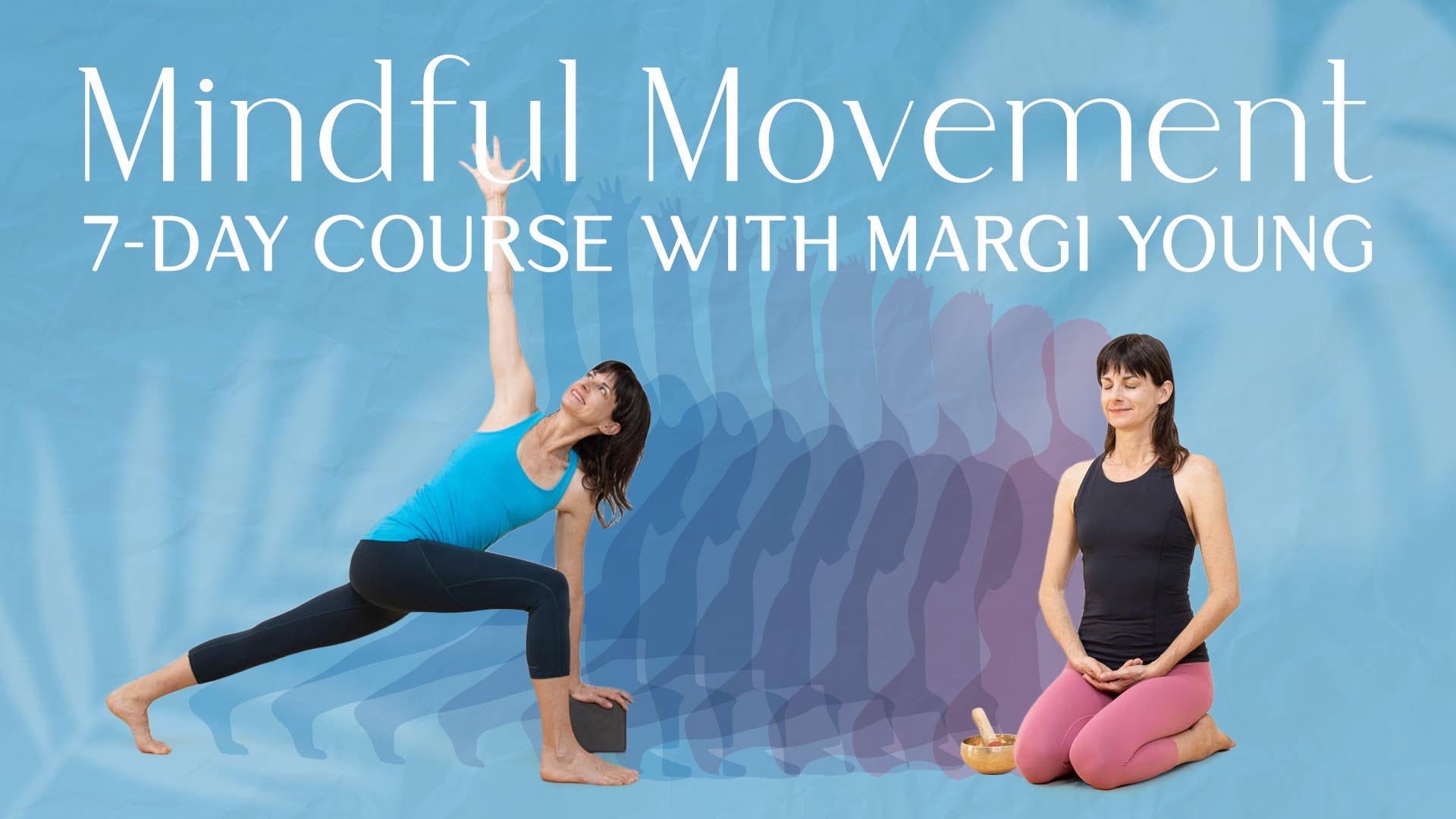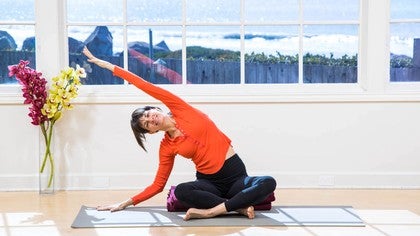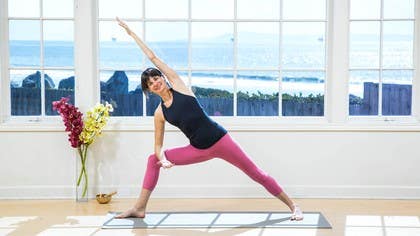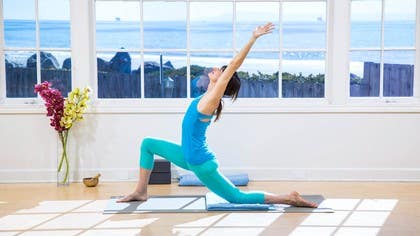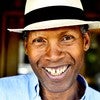Description
In Day 1, at the sound of the bell we are invited to go inward, connecting breath to movement through a gentle stretching and opening practice. Margi then invites us to remain curious and grounded throughout a guided meditation focusing on radical acceptance.
Our off the mat homework for Day 1 is to notice our breath at least 3 times, to take a little deeper breath than usual, and to see what impact that has. It may help to set timers throughout the day as a reminder to pause and notice the breath.
About This Video
Transcript
Read Full Transcript
Chapter 1
Hello. Welcome, day one. Here we are. We'll start by listening to the sound of the bell. I'm going to invite you to listen from the moment that I chime it all the way to the end of the bell, keeping your ears open for the duration. Feel what's touching the ground beneath you. And sense the very crown of your head floating up away from the descent of your pelvis. Bring your attention to your breath. First, just notice any feeling that you have from the air coming in and going out. And then gently and easily begin to let the breath deepen. Feel the lungs in the back as well as in the front. Every inhalation, the lungs expanding and giving the heart a little hug. Every exhalation, the lungs deflating, something in you could soften. Bring the fingertips to the floor, touching the ground beside you. And then turn your palms to face out to the side. We're going to coordinate movement with breath. So with your next inhalation, reach your arms up and overhead. And then as you exhale, slide your hands together and let them meet right in the center of the chest. We'll do that again. Fingertips to the side. Inhale, sweep out and up. You might lift your gaze a little bit. As you exhale, hands to heart center. And again, touching the ground. Just one more time like that, feeling the back of the body as you inhale, reaching the fingers high to the sky. And as you exhale, hands come right together in front of the center of the chest. And now interlace your fingers. We're going to press the palms forward and pull the abdomen back to round the spine, dropping the chin to the chest. And then come all the way up to vertical, reaching the arms up overhead. Go a little beyond vertical, so a bit of a back bend, taking the arms back, opening the front of the body. And as you exhale, round your spine, pulling the belly back, dropping the chin towards the chest. As you inhale, come all the way up to vertical and into a little bit of a back bend, floating the heart up. Exhale, rounding. And inhale, lengthening.One more time. Exhale, round. And this time as you come up, just come straight up to vertical instead of floating into a back bend, straight up. From here, we'll bring the right hand to the mat, outside of the right hip, and take a side bend. As you bend to the side, see if the shoulders can draw down away from the ears. The left hip can stay heavy and grounded. And you can reach very completely through the left side, through the left arm. Then with your next inhalation, come up to the center. And as you exhale, second side, left hand finds the ground, leaning over to the left, continuing to drop through the right thigh, the right hip, and just feeling the breath in the right side. And with the next inhalation, come up. And as you exhale, twist, looking over the right shoulder, bringing the left hand to the right leg, right fingertips behind you. Continue to feel what's touching the ground descend, and the crown of the head floating up. Continue to feel the breath in the back of the body, as well as in the front. And notice how the breath affects the twist. With your next inhalation, get taller as you come to the center. And as you exhale, turning to the left. The spine, kind of like an old fashioned barbershop pole, spiraling upwards. Every exhalation, a chance to soften, in that softening, there might be some deepening. With your next inhalation, come to the center, float your arms up. And as you exhale, slide your hands together in front of your heart. So far in this practice, we have done the six movements of the spine. All of these movements are what get repeated through a yoga practice.
And in turn, we get to have more clarity in the center. So the forward bend, the backward bend that we did, the side bends, and the twist. Those are all of the movements of the spine, which we'll be exploring together. We will practice them now on hands and knees. So if you could transition to your hands and your knees, and you're welcome to put a blanket underneath your knees, if your knees feel at all tender onto the ground, it's important that you take good care of yourself in this practice of yoga, which is a healing practice. So setting up on hands and knees with the shoulders directly over the wrists and the hips directly over the knees. Spread your hands wide like starfish with your index fingers pointing straight forward. So here we go into our back bend. It's called cow pose, head and tail, lift up the spine arches. And then as you exhale, round, dropping the head, dropping the tail. Inhale into the back bend, the pubic bone moves back and the chest lengthens forward. And as you exhale, pressing into the hands, rounding the spine, dropping the head and the tail. Do a couple more times on your own and see if you can have the intention of this feeling really good as you break up any unnecessary gripping or tensions along the spine. As we practice together, you're always welcome to modify, change, take a break at any point.
I'm just going to invite you to stick on your mat, but find your way through the practice. You'll come into a neutral spine and we'll do our twist. So we'll reach the left arm up towards the ceiling, turning up and then thread the left arm underneath the right arm, bringing the back of the left shoulder to the ground. Let your head rest onto the ground and take a few breaths here, feeling this twist, feeling the shoulder opening and anything else that you feel. I like this one because it brings attention to the back body where the kidneys are, the adrenals are, the back of the lungs where there's lots of lung tissue. And then with your next exhalation, come back onto hands and knees, established center, and then the right arm will lift up towards the ceiling. And as you exhale, thread your right arm through, laying the back of the right arm, the right side of the head, and put your left hand wherever it feels comfortable. And then breathing here, feeling, breathing, give yourself permission to feel whatever it is that you feel and use those sensations to keep your attention anchored in your body. Practicing mindfulness in movement. With your next exhalation, come back onto your hands and your knees. We're going to take the right leg back, put the toes onto the mat, and then take your right leg across your midline and look over your left shoulder. So this is the side bending movement. Breathing into the right lung, feeling the right rib spread. And then bring your leg back, bring your spine back, and we'll bring that knee down to the ground. Second side, left toes go back. Take your left leg across your midline and then look over your right shoulder. You may see your left foot over there. The left ribs doming open. Breathing into that side. And then bring your leg back, bring your spine back, bring your knee down, then widen your knees so they're a little bit wider than your hips. Let your big toes touch together and then bring your pelvis back towards your heels and bring your forehead down to the ground. If your forehead doesn't reach the ground easily, please put the forehead up onto a blanket or a block so that you can easily have some foundation for the head. The integral part of Child's Pose is that the brain gets to rest to the forehead, to the earth. If this is not good for your knees, you could put a blanket here in between your thighs and your calves. We'll move along. We'll come back onto hands and knees and then walk your hands about three inches further forward. Tuck your toes under. See if you can widen across your chest and then lift your knees a little bit up off of the mat, rooting through the entire hand. And then draw your pelvis up and back away from the rooting of your hands. See if you can get into a clear line between your hands and your hips. And then from there, straighten just one leg, reading the hamstrings and the calf. And then bend and straighten the other leg. And one more time. Bending one knee and then bending the other knee. And then keep both knees bent. Press into your hands. See if you can pull the pelvis even back and up a little bit further away from the rooting of your hands so you're extending your spine between your hands and your hips. See if you can keep that length in the spine as you straighten your legs. If not, it's perfectly fine to keep the knees bent. Relax a bit through your neck and your head, your jaw, your tongue. And then with your next exhalation, bring your knees to the floor and go back into child's pose, resting here. Feeling the breath move into the back surface of your body as you drop any effort. We'll reach the arms way forward again, extending the arms. And then come back into downward facing dog. From here, we'll slide forward, come into plank position. Plank is the top of a pushup. You might have to move your feet back a bit. And then let your hips go up and back into downward facing dog. You just stay in this long dog. Again, plank position, head forward, heels back. Exhale, legs pull you up and back into downward facing dog. One more like that. Inhale forward to plank, feeling the whole body engaged in this plank pose. And as you exhale back into downward facing dog. From here, we'll walk the hands back, carefully if you have a blanket on your mat, not to slip. And at the back of the mat, we'll bend the knees and hang over for a few breaths. Let's hold on to elbows and rest here. From here, we'll release the arms, bend the knees and roll up bone by bone, letting your head be the last thing to stack on top. And here we are in mountain pose. We'll turn the palms to face out. Inhale, reach the arms out and up. As you exhale, cascade over your legs, back into your forward fold, dropping the head at the bottom. And then bring your hands gently onto your shins and pull your chest forward, coming into an extended spine. And then fold back over your legs, dropping your head, letting the spine rest down, rooting into the feet. Come back to stand, reaching the hands up to the sky. And as you exhale, hands to prayer and down to your sides. This is a half sun salutation. We'll do it again. Inhale, we reach up. Exhale, fold forward. Inhale, hands to shins, lengthening the spine. Exhale, releasing back over the legs. Feel the feet root as the spine comes up, hands join. Exhale, hands to heart. We'll do this sequence on other days, so you've got to be a pro at it soon. All right, let's turn to face the side. So your feet can be on the mat and we'll take the feet wide apart and bring the hands onto the hips. Lift your toes, spread them wide, and then place them back down onto the mat. Take your arms down and then inhale, sweep up with the arms. Exhale, hands to heart center. Like we did at the beginning of the practice. Again, inhale, reach up. Exhale, hands to heart center. Keep the legs really strong as the arms are fluid.
Exhale, rising up. And exhale, hands to the heart center. And then bring your hands back to your hips. Press down into the hips, lift your chest up. Here we are in a little baby back bend. As you exhale, keeping the legs strong, fold forward, coming halfway forward, finding that extended spine position. And then as you exhale, bring your hands down. If they don't reach the ground, you could put them on your blocks and fold forward, letting your head release down. Notice where you feel stretch. Notice where you feel strength. See if there's anything you could let go of here. And then we'll just shift the weight. Bend one knee, shifting to that side, and then keeping the pelvis low, bend the other knee, shifting from side to side to open the long muscles on the inside seams of the legs. And then come back to the center. We'll bring the hands to the hips and inhale all the way up to stand. And then bring your feet together at the top of your mat. Feel Tadasana, the mountain pose, steady on the feet, strong on the legs, long through the spine, the breath coming in and out. With an inhalation, reach your arms up. As you exhale, fold all the way over your legs. We'll step back into our downward facing dog. With an inhalation, come forward to plank position. And then as you exhale, bring your knees to the floor and then slowly, slowly lower your chest all the way down to the ground. From here, we'll flip over onto our backs. And then we're going to do a pose called Viparita Karani. We start on the back, feet down, and you can put a blanket or you could use a block or a pillow, any prop that you have lying around, and rest your pelvis down onto that prop. So we'll bring the legs, one at a time, up towards the ceiling. If you feel like this is a big grip in your abdomen or your hip flexors, let your knees bend slightly so there can be a soft quality to the hips and the belly. One thing I really love about the yoga practice is when we get to turn ourselves upside down, which has all kinds of benefits. My favorite is to just shift my perspective on the world. All right, we'll bring the feet back down to the mat, lift your pelvis up, move the prop over to the side, and then slowly lower yourself bone by bone down to the mat. From here, we'll widen the feet so they're mat distance apart, and then take both of your knees over to the right side, and then both the knees over to the left side. This one has a good name, the windshield wipers. Let your knees just go easily from side to side. And as you're doing this, have some attention on your breath. All right, then we'll come to the center and let the knees just drop in towards each other. You might want to lift your pelvis a little bit, lengthen through your low back, and then place your pelvis down onto the ground. We'll reach the hands up towards the ceiling and cross your arms. Let your elbows just fall down towards the chest. This pose is called constructive rest. And if it does not feel restful to you, please find another way to rest just for a few moments here before we move into our seated meditation practice. Deepening the breath. It's important to come out of the restful Shavasana lying down poses by rolling over to your sides. You come out keeping the nervous system quiet.
You press into the floor with your hands and come up to sit. And we'll move now into our meditation practice. I'm going to get my chair to sit on for ultimate ease and comfort. Welcome
Chapter 2
to day one of our meditation practice. I'd like to pose an idea that it's been on my radar for a long time. It's the name of a book by Tara Brock called radical acceptance. And I'm going to invite you throughout our meditation practices together to open to whatever arises. I was just listening to a podcast with Lady Gaga and Oprah and Lady Gaga was also talking about practicing radical acceptance. So it's floating around out there. We are looking not to beat ourselves up for anything that happens here, but to open and be curious and notice what happens in our minds and in our bodies and in our hearts as we slow down and get a little quiet. So we'll start by finding a seat. You see I'm sitting in a chair. I have the tutorial on finding a seat if you're not quite sure about what's the most comfortable position for you. It might shift from day to day how you want to sit. But just find a place where you can be relatively comfortable and steady. And then the eyes can either be closed or gently open. If your eyes are open they'll rest onto the floor in front of you with a quiet gaze. If the eyes are closed also let there be a feeling of stilling the eyes and the pupils of the eyes become still. This meditation practice comes from the Buddha and he started teachings by talking about the body. Feeling into whatever is touching the ground. Having a feeling of rooting or anchoring or dropping into the earth beneath you. And then some lift or lightness in the spine. And I recently saw some hot air balloons up in the sky and I thought about how I want my head to feel in meditation. A lightness, a lift up through the head. Maybe a slight lift to the back of the head like you have antenna coming up towards the sky. And then just notice how you're breathing without changing the breath. In any way notice your natural breath. Invite an easy attention to the breath like a butterfly landing on a leaf. Just a gentle awareness. We started the movement practice by listening outwards to the sound of the bell. This is an inward listening or observing of the sensation of breath. When you notice your mind starts thinking it's normal. Just guide it back to the breath with gentleness and kindness. Training remembering to accept whatever arises. Open to it. Notice the wanderings of the mind and then come back to the body, come back to the breath. To finish this meditation I'll ring my bell. And if you could just listen to the sound of the bell from the beginning to the end. Just shifting the attention from inwards toChapter 3
outwards. Thank you for practicing. So it's very important that the yoga and meditation practice says don't stay isolated to the mat or the cushion but that we use the work that we do here to go out into the day and greet others and do our work and exist with a sense of openness and compassion and ease and awareness. Anything that your practice teaches you. You want to take those qualities out with you. So this is a little off the mat homework until we meet again. I'd love for you just to notice your breath. We did a lot of breath work through the active practice and then noticing the breath and meditation three times between now and when we meet again. At least three times. Just notice your breath and take a deeper breath or two. If you do this when you feel life is a little stressful it's extra special time to do that. It will have a big impact when life turns into a tornado if you can possibly remember to take a breath. See what impact that has. If this seems like you might forget you could set a couple of timers throughout the day. When your timer goes off take a deep breath. We'll see how that goes and I hope to see you tomorrow for day two.Thank you so much for joining me. Namaste.
Mindful Movement
Comments
You need to be a subscriber to post a comment.
Please Log In or Create an Account to start your free trial.

